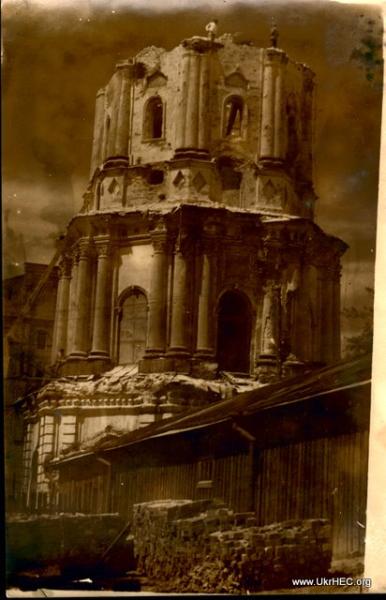Posted on May 17, 2022

We have witnessed tremendous destruction as a result of the Russian invasion of Ukraine. Not only have we seen wanton attacks on hospitals, apartment buildings, and civilian infrastructure—resulting in tremendous suffering and displacement—we have also seen indiscriminate destruction of buildings of historical significance.
This is nothing new, of course. Previous wars have had similar brutal effects, but the scale cannot be compared: Kharkiv in just the first few weeks of the current war sustained more damage than it did in the entirety of World War II (during which the front lines passed through the city multiple times).
But we don’t need war to have architectural destruction. This photograph (from the archival collection of Konstantyn Moshchenko at the UHEC) shows the demolition of the bell tower of Kyiv's St. Nicholas Cathedral in 1934. If you look carefully at the top and partway up the left, you can see "deconstruction workers" dismantling the masonry.
The St. Nicholas Cathedral was one of the many churches commissioned by Ivan Mazepa and was consecrated in the late 1600s. The bell tower in the Rastrelli style seen here was added in the mid 1700s. In the 1800s, it came under the patronage of the Russian Imperial Army, giving it the name “St. Nicholas Military Cathedral”.
The year 1934 was critical. That was the year that the capital of Soviet Ukraine was transferred from Kharkiv to Kyiv, and it coincided with efforts by the Bolshevik authorities to destroy churches, particularly those associated with Mazepa, seeing them as focal points for “Ukrainian bourgeois nationalism”.
Coincidentally, this cathedral witnessed a major event in Ukrainian religious life in the early 20th century: on May 22, 1919 it was the site of the first Liturgy ever to be celebrated in the vernacular Ukrainian language. The celebrant was Fr. Vasyl Lypkivs’kyi, who in a few years would become the Metropolitan of the Ukrainian Autocephalous Orthodox Church of 1924. Musical settings were created specifically for the occasion by the noted Ukrainian composer Mykola Leontovych, who also directed the choir. Leontovych, in another fascinating coincidence, was also the creator of the arrangement of the children’s winter cycle ritual song “Shchedryk”, which is now known worldwide as the “Carol of the Bells”.
